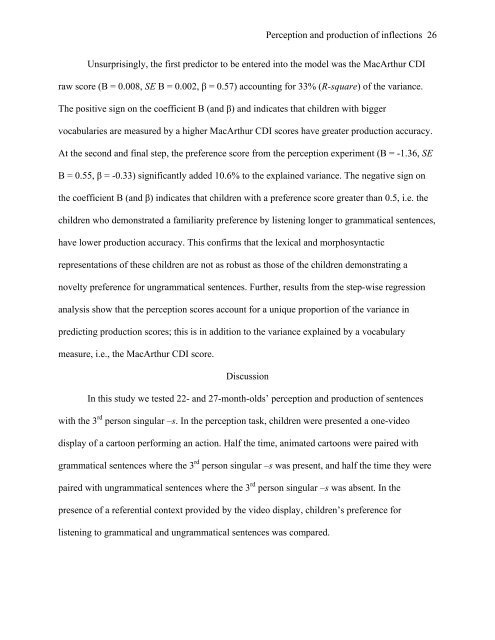Perception and production of inflections 1 Sentence-position effects ...
Perception and production of inflections 1 Sentence-position effects ...
Perception and production of inflections 1 Sentence-position effects ...
Create successful ePaper yourself
Turn your PDF publications into a flip-book with our unique Google optimized e-Paper software.
<strong>Perception</strong> <strong>and</strong> <strong>production</strong> <strong>of</strong> <strong>inflections</strong> 26<br />
Unsurprisingly, the first predictor to be entered into the model was the MacArthur CDI<br />
raw score (B = 0.008, SE B = 0.002, β = 0.57) accounting for 33% (R-square) <strong>of</strong> the variance.<br />
The positive sign on the coefficient B (<strong>and</strong> β) <strong>and</strong> indicates that children with bigger<br />
vocabularies are measured by a higher MacArthur CDI scores have greater <strong>production</strong> accuracy.<br />
At the second <strong>and</strong> final step, the preference score from the perception experiment (B = -1.36, SE<br />
B = 0.55, β = -0.33) significantly added 10.6% to the explained variance. The negative sign on<br />
the coefficient B (<strong>and</strong> β) indicates that children with a preference score greater than 0.5, i.e. the<br />
children who demonstrated a familiarity preference by listening longer to grammatical sentences,<br />
have lower <strong>production</strong> accuracy. This confirms that the lexical <strong>and</strong> morphosyntactic<br />
representations <strong>of</strong> these children are not as robust as those <strong>of</strong> the children demonstrating a<br />
novelty preference for ungrammatical sentences. Further, results from the step-wise regression<br />
analysis show that the perception scores account for a unique proportion <strong>of</strong> the variance in<br />
predicting <strong>production</strong> scores; this is in addition to the variance explained by a vocabulary<br />
measure, i.e., the MacArthur CDI score.<br />
Discussion<br />
In this study we tested 22- <strong>and</strong> 27-month-olds’ perception <strong>and</strong> <strong>production</strong> <strong>of</strong> sentences<br />
with the 3 rd person singular –s. In the perception task, children were presented a one-video<br />
display <strong>of</strong> a cartoon performing an action. Half the time, animated cartoons were paired with<br />
grammatical sentences where the 3 rd person singular –s was present, <strong>and</strong> half the time they were<br />
paired with ungrammatical sentences where the 3 rd person singular –s was absent. In the<br />
presence <strong>of</strong> a referential context provided by the video display, children’s preference for<br />
listening to grammatical <strong>and</strong> ungrammatical sentences was compared.
















